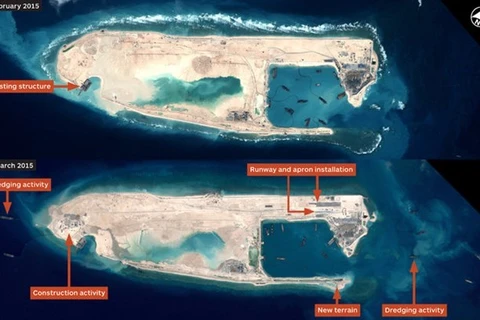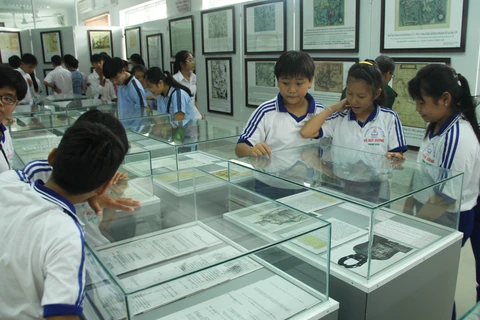Da Nang (VNA) – Tran Duc Anh Son, Deputy Director of the Institute for Socio-Economic Development (ISED) in Da Nang, on January 19 donated to Hoang Sa district several documents and old maps that clearly establish Vietnam’s sovereignty over the Hoang Sa (Paracels) and Truong Sa (Spratly) archipelagos.
Son said he collected these documents at the libraries of Yale and Harvard universities as well as the Library of Congress during a 10-month stay in the United States last year.
He said the collection, which comprises maps, books and bibliography covering Vietnam, China and Japan in the 16th and 19th centuries, clearly show Vietnam’s sovereignty over the Hoang Sa (Paracels) and Truong Sa (Spratly) archipelagos.
“I also found documents related to conflicts and disputes on sovereignty of islands in South China Sea (known as East Sea in Vietnam). Some documents and files clearly explain the disputes of the Hoang Sa and Truong Sa archipelagos among various parties, and the illegal occupation of the Hoang Sa islands by force by China on January 19, 1974,” Son said at the donation ceremony.
“I also collected old maps published during the times of the Ming and Qing dynasties between the 16th and early 20th century which clearly show that China’s borders did not include the Hoang Sa and Truong Sa islands,” he said.
He said a 200-page geographical map detailing China’s territory under the Quianlong Emperor in 1760 does not include the two archipelagoes.
Even the 1885-printed Atlas von China that the Qing dynasty commissioned the German Verlag von Dietrich Reimer publishing house to produce, including 55 coloured administrative and terrain maps of Beijing and 26 prefectures under the Guangxu Emperor (1875-1908), do not show any sovereignty over the Hoang Sa and Truong Sa archipelagoes.
He said the atlas, which has a 16-page explanation in German, does not refer to China’s sovereignty over the archipelagoes.
Also the same day, the Hoang Sa District People’s Committee organised a meeting of 12 people who had lived, worked and protected the Hoang Sa archipelago in the 1959-1974 period.
Last week, an American-Vietnamese collector, Tran Thang, had donated to the district the Pattie De La Conchinchine, an 1827 map printed in the six-volume World Atlas (Atlas universel) by Belgium cartographer Phillippe Vandermaelen (1795-1869).
The map is one of the most detailed maps indicating clearly Vietnam’s sovereignty over the Hoang Sa islands.
Ly Son island, 30km offshore from Quang Ngai province, still preserves the Am Linh Pagoda, a place of worship for seamen dispatched to the Hoang Sa islands since the 17th century during the reign of the Nguyen Dynasty.
A museum of the two archipelagoes displays over 200 ancient documents and 100 objects proving that the Hoang Sa and Truong Sa archipelagoes belong to Vietnam.-VNA
Son said he collected these documents at the libraries of Yale and Harvard universities as well as the Library of Congress during a 10-month stay in the United States last year.
He said the collection, which comprises maps, books and bibliography covering Vietnam, China and Japan in the 16th and 19th centuries, clearly show Vietnam’s sovereignty over the Hoang Sa (Paracels) and Truong Sa (Spratly) archipelagos.
“I also found documents related to conflicts and disputes on sovereignty of islands in South China Sea (known as East Sea in Vietnam). Some documents and files clearly explain the disputes of the Hoang Sa and Truong Sa archipelagos among various parties, and the illegal occupation of the Hoang Sa islands by force by China on January 19, 1974,” Son said at the donation ceremony.
“I also collected old maps published during the times of the Ming and Qing dynasties between the 16th and early 20th century which clearly show that China’s borders did not include the Hoang Sa and Truong Sa islands,” he said.
He said a 200-page geographical map detailing China’s territory under the Quianlong Emperor in 1760 does not include the two archipelagoes.
Even the 1885-printed Atlas von China that the Qing dynasty commissioned the German Verlag von Dietrich Reimer publishing house to produce, including 55 coloured administrative and terrain maps of Beijing and 26 prefectures under the Guangxu Emperor (1875-1908), do not show any sovereignty over the Hoang Sa and Truong Sa archipelagoes.
He said the atlas, which has a 16-page explanation in German, does not refer to China’s sovereignty over the archipelagoes.
Also the same day, the Hoang Sa District People’s Committee organised a meeting of 12 people who had lived, worked and protected the Hoang Sa archipelago in the 1959-1974 period.
Last week, an American-Vietnamese collector, Tran Thang, had donated to the district the Pattie De La Conchinchine, an 1827 map printed in the six-volume World Atlas (Atlas universel) by Belgium cartographer Phillippe Vandermaelen (1795-1869).
The map is one of the most detailed maps indicating clearly Vietnam’s sovereignty over the Hoang Sa islands.
Ly Son island, 30km offshore from Quang Ngai province, still preserves the Am Linh Pagoda, a place of worship for seamen dispatched to the Hoang Sa islands since the 17th century during the reign of the Nguyen Dynasty.
A museum of the two archipelagoes displays over 200 ancient documents and 100 objects proving that the Hoang Sa and Truong Sa archipelagoes belong to Vietnam.-VNA
VNA
























